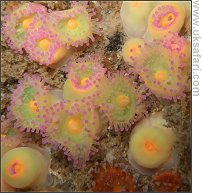
|

|
|
 Sent
to you Sent
to you
by e-mail
|
|
Simply
enter your details and hit the send button
more
info |
|


Click Here

Links
Advertise
Terms of Use
Contributors
About Us
Contact Us
|
 |
Go back
 | Bookmark
| Bookmark
 | Print Page
| Print Page  | E-Mail Us
| E-Mail Us 
 

Photo: Beverley Hills |
|
UK
Safari Tip:
Need help identifying wildlife on the seashore? Try this beautifully illustrated fold out ID chart -
click
here
|
|
See larger image
Latin name: Corynactis viridis
Size: Closed approx. 10mm - tentacles approx. 25mm.
Distribution: Found mainly around the west coasts of the UK from Cornwall to
the Shetlands.
Months seen: All year round.
Habitat: Rocky coasts - especially below overhanging rocks.
Food: Marine invertebrates
Special features: The jewel anemone gets its name from its spectacular colouration. They are some of the most colourful anemones found in UK
waters. The main body known as the ‘column' can be green, white, orange, blue, pink or red.
Each anemone has up to 100 knobbed tentacles. The tentacles are normally a contrasting colour to
column. At the centre of the tentacles is the mouth.
The jewel anemone reproduces asexually in a process known as 'longitudinal fission'
which basically means the anemone splits in half. The two resulting small anemones can then grow, and split
again which is why these anemones can be found in large patches.
Jewel anemones look similar to a coral, but they lack a calcified skeleton

UK Safari Marine Section
|
 |

|